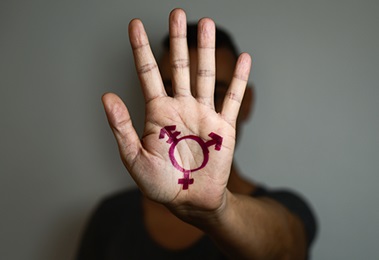Facial Masculinization Surgery
Featured Expert:
Facial masculinization is a series of plastic surgery procedures designed to create a more masculine appearance of the face for patients undergoing gender affirmation treatment. Fan Liang, M.D., of the Johns Hopkins Center for Transgender and Gender Expansive Health reviews what patients should know.
What You Need to Know
- Facial masculinization surgery may be part of the treatment approach for a person who desires a more masculine facial appearance.
- Facial masculinization procedures can reshape the forehead, brows, nose, cheeks and jaw as well as create the appearance of an Adam’s apple.
- Procedures may use cosmetic fillers or implants to create masculine facial features.
- The surgeon may recommend a staged approach, based on your priorities.
What is facial masculinization surgery?
Facial masculinization surgery is a series of procedures that can reshape the face and its features to achieve a more masculine appearance.
Who may benefit from facial masculinization surgery?
Masculinization procedures may be appropriate for transgender people, especially those experiencing gender dysphoria ― distress due to a discrepancy between their physical appearance and the gender with which they identify.
Facial procedures may be part of an overall plan of gender affirmation, the therapeutic process of aligning the appearance of the face and body with a person’s gender identity.
Facial Masculinization Procedures
Your surgeon will work with you on an individualized treatment plan, which may include one or more procedures to target areas of the face where you desire a more masculine appearance.
The goals of facial masculinization are different from facial feminization. “Whereas facial feminization typically involves surgery to make some facial features smaller and less prominent, facial masculinization can involve adding to the nose, brow, jaw angle and other features using implants, cartilage or fillers,” Liang says.
The best surgical approach to facial masculinization considers the face as a whole, and works to ensure all the facial features balance and complement one another.
Brow
A higher, flatter-looking forehead can look more masculine than a softer, rounded one. Increasing the brow ridge and the distance between the eyebrows and the hairline can also create a more masculine look.
- To increase the length of the forehead, hair removal can be used.
- The brow ridge, the horizontal ledge of bone above the eyebrows, is another area that can be augmented with an implant since males typically have a more prominent bone structure in this area.
Adam’s Apple
Testosterone therapy, which may be part of a patient’s gender affirmation treatment, is not usually enough to help grow an Adam’s apple, the bulge of cartilage in front of the thyroid gland in the middle of the neck that is prominent in most males.
Inserting a Y-shaped implant can create this look. Newer techniques use an implant made of the patient’s own cartilage, harvested from the rib cage.
After making an incision in the neck, the surgeon places the implant and gently separates the muscles. After positioning the implant and securing it with sutures (stitches) so it can move naturally up and down as the person speaks and swallows, the muscles are guided back into place and the incision is closed.
Nose
Reshaping the nose for facial masculinization requires special skill and artistry, since the nose is the focal point of the face.
Male noses are generally larger and broader than females’. Reshaping nose surgery (rhinoplasty) can make the nose more prominent and masculine in shape (e.g., wider at the bridge or not turned upward at the tip.) Different approaches can build up areas of the nose using implants or the patient’s own cartilage or bone grafts. The surgeon can correct any bumps or unevenness at the same time.
Nose masculinization surgery uses incisions located either inside the nose or under the base where the nose meets the upper lip. This way, visible scars are absent or barely detectable.
Rhinoplasty may be recommended to harmonize the appearance of the nose with other facial features that are being surgically addressed, such as the forehead and brow.
Chin and Jaw
A broad, angular jaw and a strong chin are part of a masculine face. Building up the chin and angle of the jaw may be accomplished with moving the bone or by adding implants.
The surgeon inserts the implants through an incision inside the mouth. With this approach, a scar will not be visible.
Implants placed at the angle of the jaw make it wider and squarer. Some types of implants are designed to continue along the edge of the jaw and augment the chin. Or the surgeon may use separate chin implants.
About Fillers and Implants
Fillers and implants may be used in facial masculinization surgery to emphasize or enlarge a feature or area of the face. Here’s how they compare.
Fillers are injectable materials that can reshape or enlarge a facial feature.
- Pros: Using fillers is quicker and easier than surgery. In some cases, a doctor can inject them in the office.
- Cons: The results are temporary, so repeat injections may be necessary. Also, the amount of filler that can be safely injected into the face is limited, and may not be sufficient to achieve the desired look.
Fillers may not be covered by insurance.
Complications are rare when cosmetic fillers are injected by a skilled doctor, but are possible, and include:
- Lumps or asymmetry (a lopsided or uneven appearance)
- Infection
- Bruising
- Bleeding
- Acne-like skin eruption
- Skin damage with possible scarring
Implants are solid pieces of cartilage or manufactured material (such as silicone or plastic) that are inserted under the skin to enlarge, emphasize or change the shape of a facial feature.
- Pros: Implants can create lasting results.
- Cons: Implants require surgery with anesthesia. The cost may be much higher than that for getting fillers and may not be covered by insurance.
Liang notes that implants are generally safe. Rare side effects include:
- Rotation ― the implant turning or otherwise moving out of position beneath the skin
- Infection
- Extrusion ― the implant works its way out of the skin
- Allergies to the materials in the implants or those used in the surgical process
- Infection
- Scarring
- Numbness in the surgical area
Also may not be covered by insurance
Preparing for Facial Masculinization Surgery
Before the first consultation, the surgeon may request a CT scan that shows your facial bones and soft tissue. These images help the surgeon plan your surgeries and provide a baseline for evaluating results after your procedures are finished.
Once the plastic surgery team has worked with you to develop a plan that best meets your needs and preferences, it is time to schedule your procedure(s).
When multiple surgeries are desired, the surgeon may plan a staged approach, with the procedures spaced out and performed on different days. Staging surgery may be safer than attempting to perform too many procedures at the same time, which can keep you under anesthesia for a prolonged period.
Hormones for Facial Masculinization
Taking hormones may be part of your transition plan. Liang explains that taking testosterone can encourage the growth of facial hair and make the facial skin texture thicker while increasing the production of facial oil (sebum).
“The muscles of the face may enlarge slightly, which can make the face appear less delicate,” she says.
For people in whom hormone therapy is not enough to achieve desired gender affirming changes to the face, surgery can help.
Your Procedure
How long it takes: This depends on what you are having done. Administering cosmetic fillers may take an hour or less, while complex facial surgery may take several hours.
Staying in the hospital: Your procedure may be performed in a hospital or outpatient center. Some facial plastic surgeries involve a day or so in the hospital for observation and to ensure you are healing properly before you are released to go home.
First clinical follow-up: This usually occurs within one week of surgery, and will be scheduled before you leave.
Facial Masculinization Recovery
The course of recovery for the different procedures can vary, and it can be influenced by your general state of health and your self-care after surgery.
Though the procedures are largely safe, it is important to call your doctor right away if you develop a fever, severe pain or other signs of infection, or if you have any other concerns. Here are some basics for recovery after facial surgery:
Bruising and swelling: These are common side effects after facial plastic surgery. Bruises, including black eyes, may take four to six weeks to clear up.
Pain and discomfort: Most people experience some discomfort for four or five days after surgery, but this should begin to ease, allowing you to gradually return to normal activities. Your doctor will provide instructions on returning to work and exercise, along with other tips on what’s safe to do and when. You may have temporary restrictions on heavy lifting, vigorous exercise or other activities.
Bandages and dressings: Do not remove tape, gauze, drains, splints or compression dressings: The doctor will take off these items and examine the surgical area at your first clinical appointment after your procedure.
Bathing and showering: Avoid showering, and gently sponge bathe instead until you return for your first post-surgery appointment and your doctor says it is OK to resume showering. When bathing or showering, be sure to use unscented soap, and never allow the water to directly spray the surgical area. Do not shave or use hair-removal processes such as waxing until your doctor clears you to resume these practices.
The Center for Transgender and Gender Expansive Health Team at Johns Hopkins
Embracing diversity and inclusion, the Center for Transgender and Gender Expansive Health provides affirming, objective, person-centered care to improve health and enhance wellness; educates interdisciplinary health care professionals to provide culturally competent, evidence-based care; informs the public on transgender health issues; and advances medical knowledge by conducting biomedical research.







